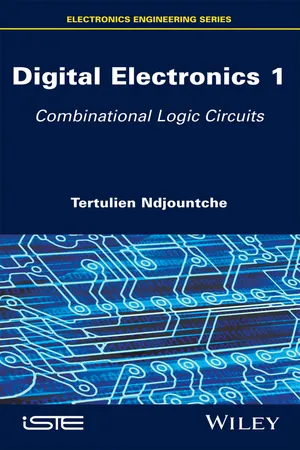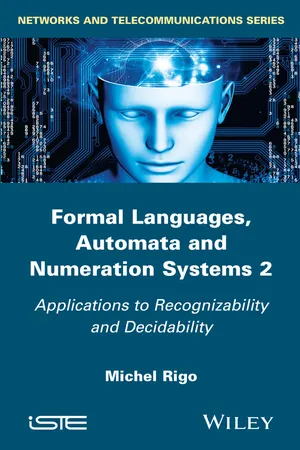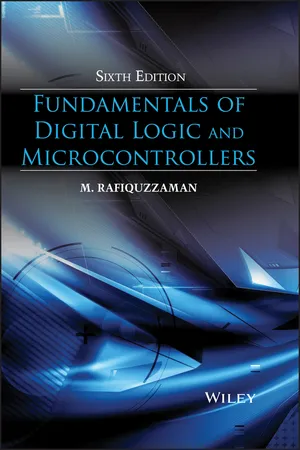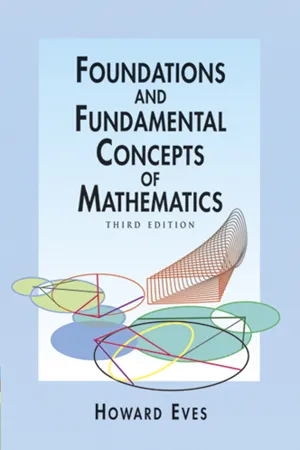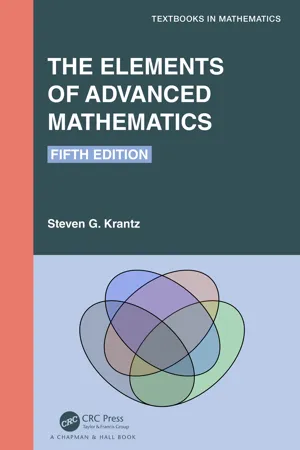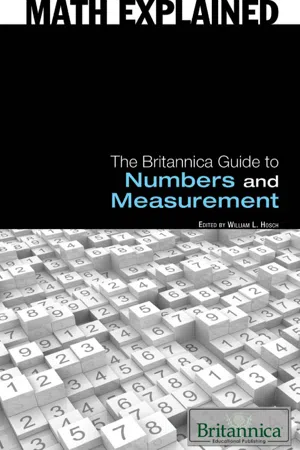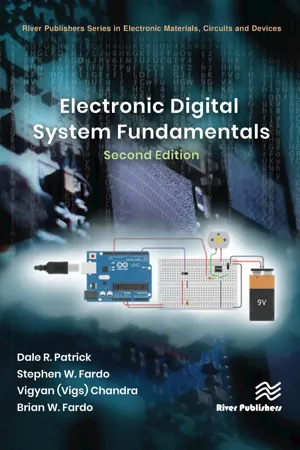Mathematics
Number Systems
Number systems are the different ways of representing numbers, including decimal, binary, octal, and hexadecimal systems. Each system has its own base and set of symbols for representing numbers. The decimal system, for example, is base 10 and uses the digits 0-9, while the binary system is base 2 and uses only 0 and 1.
Written by Perlego with AI-assistance
Related key terms
Related key terms
1 of 4
Related key terms
1 of 3
12 Key excerpts on "Number Systems"
- eBook - ePub
Digital Electronics 1
Combinational Logic Circuits
- Tertulien Ndjountche(Author)
- 2016(Publication Date)
- Wiley-ISTE(Publisher)
1 Number Systems1.1. Introduction
Digital systems are used to process data and to perform calculations in most instrumentation, monitoring and communication devices. As physical quantities and signals can only take discrete values in a digital system, the interpretation of real-world information requires the use of interface circuits such as data converters.In general, numbers may be represented in different numeration systems. The decimal system is commonly used in routine transactions while the binary system is the basis for digital electronics. Every number (or numeration) system is defined by a base (or radix), which is a collection of distinct symbols. The representation of a number in a numeration system may be considered as a change in base. In a positional number system, a value of a number depends on the place occupied by each of its digits in the representation.1.2. Decimal numbers
The decimal number system uses the following 10 numbers or symbols: 0, 1, 2, 3, 4, 5, 6, 7, 8, 9. The radix is thus 10. EXAMPLE 1.1.– Decompose the numbers 734 and 12345 into powers of 10. The decomposition of the number 734 takes the form: For the number 12345, we have: Depending on its position, each number is multiplied by the appropriate power of 10. The right-most digit represents the unit digit.1.3. Binary numbers
Binary number system is based on two-level logic, conventionally noted as 0 (low level) and 1 (high level). It is a system with a radix of two. - eBook - ePub
Formal Languages, Automata and Numeration Systems 2
Applications to Recognizability and Decidability
- Michel Rigo(Author)
- 2014(Publication Date)
- Wiley-ISTE(Publisher)
2
A Range of Numeration Systems
The way we do arithmetic is intimately related to the way we represent the numbers we deal with. Donald E. Knuth [KNU 12]It is not possible (or it would deserve a complete volume) to give a comprehensive presentation of the various and exotic numeration systems that have so far been developed. Many clever non-standard systems were devised to solve relevant problems, create better or easier computational procedures, define convenient codings, etc. Numerical algorithms depend on the chosen representations. The mathematical notion of a number (e.g. integers, real numbers, complex numbers, vectors of these, ...) is independent of any chosen representation, but the way we represent or expand numbers has an influence on how operations on these numbers will be performed (e.g. comparison, addition, parallelization or pipelining of a series of computations).EXAMPLE 2.1.– Take the usual base-2 expansions. Using the digit set {0, 1}, every positive integer n has infinitely many representations of the form 0j c k ··· c 0 where j ≥ 0, c k ≠ 0 and . Using the digit set {1, 2}, every positive integer has a unique expansion. Finally, with the digit set {−1, 0, 1}, we can represent positive as well as negative integers. In that case, addition of two numbers can be performed in parallel, because we can get rid of carry propagation using Avizienis’s algorithm [AVI 61].Each of these three variants of the binary system is what we call a positional numeration system (PNS). There exists a sequence (Ui)i ≥0of integers – here the sequence (2i )i ≥0– such that every wordck··· c 0 is a representation of the integer . Roughly speaking, the weight of the digitcjdepends on its position within the word. If the sequence (Ui)i ≥0is increasing, the leftmost non-zero digit (respectively, the rightmost digit) is, thus, referred to as the most significant (respectively, least significant - eBook - ePub
Digital Electronics: A Primer
Introductory Logic Circuit Design
- Mark Nixon(Author)
- 2015(Publication Date)
- ICP(Publisher)
Chapter 7
Number Systems, Coding, and Arithmetic
7.1 Numbers and Coding Systems
7.1.1 Common number coding systems
T he basic form of a number is a collection of digits arranged into integer and fractional parts. The digits are arranged in order of significance and numbers are left justified when the most significant digit is to the left. A number’s arrangement isThe part of the number to the left of the (decimal) point is an n + 1 digit integer and the part to the right is an m digit fraction. The base of the number is called its radix and this is denoted by r in the number. Each digit is multiplied by the radix raised to the power associated with that digit. The least significant digit in the integer part is actually D0 × r0 and the radix part is omitted, since r0 = 1. In order to avoid confusion, the radix is often used as a subscript to denote the number system used, so 1110 denotes 11 in the decimal system, whereas 112 denotes a binary number (310 ). A decimal number is base 10 and so the radix r is 10. The decimal system uses ten symbols, 0, 1, 2. . .9. The number 1874.2810 is thenThe binary system has only two values. The radix is two and the two symbols are 0 and 1. Each digit in a binary number is known as a binary digit or bit. In natural binary, the number 1101.012 represents the numberIf you want to be mega pedantic, it’s now called a ‘binary’ point, not a decimal point. When I (once) called it a binary point in lectures, some guy at the front muttered ‘get a life’. Good point (sic).And in decimalBinary coded decimal (BCD) uses decimal digits coded using the binary system. The codes for each digit follow the binary sequence, starting with 010 = 00002 , 110 = 00012 , 210 = 00102 through to nine, which is represented by 10012 = (1 × 8 + 0 × 4 + 0 × 2 + 0 × 1)10 . Note that four bits are needed for each BCD digit since this allows coding of the ten digits. Six of the codes possible for the four bits (10102 through to 11112 - eBook - ePub
Information Technology
An Introduction for Today's Digital World
- Richard Fox(Author)
- 2020(Publication Date)
- Chapman and Hall/CRC(Publisher)
4The Binary Numbering System
Computers operate on data that are in any one of the states such as high or no (low) voltage. We refer to these two states using binary numbers of 1 and 0. In this chapter, we explore binary numbers so that we can understand how information can be stored in this way, and we look at the operations that we can directly perform on binary numbers. These operations are known as the Boolean operators. We then look at how to perform arithmetic operations using the Boolean operators. To start, we look at numbering systems in general before focusing specifically on binary. We also briefly consider two other numbering systems, octal and hexadecimal. The learning objectives of this chapter are to be able to:• Convert numbers from one numbering system to another • Convert positive and negative integers into binary representations and binary numbers into positive and negative integers • Describe what floating-point numbers are how their storage and processing differ from integer storage and processing • Apply Boolean operators • Explain how Boolean operators are used to perform basic binary arithmetic of addition, subtraction, negation, and comparison4.1 NUMBERING SYSTEMS
A positional numbering system (also known as a positional numeral system) is a writing system for expressing numbers. Each numbering system has a base (also called a radix). The base dictates the range of legal digits and how to interpret those digits. For instance, base 10 (decimal) uses digits 0–9, and we interpret the digits of a number in powers of 10. Specifically, a decimal number’s digits are interpreted as 1s, 10s, 100s, and so forth by referencing the 1s column, the 10s column, the 100s column, etc.Did You Know?The Roman numeral system is not positional. The letters that make up values are not digits. Instead, it is an additive/subtractive system whereby letters representing smaller values immediately before or after larger letters cause us to add or subtract. For instance, XLVII is “10 minus 50 plus 5 plus 2” or 47. - M. Rafiquzzaman(Author)
- 2014(Publication Date)
- Wiley(Publisher)
Chapter 2 Number Systems and CodesThis chapter describes the basics of Number Systems, codes, and error detection/correction. Note that adequate coverage of Number Systems and Codes is included in this chapter. This will provide sufficient background to understand the concepts described in the chapters that follow.2.1 Number Systems
A computer, like all digital systems, utilizes two states to represent information. These two states are given the symbols 0, and 1. It is important to remember that these 0's and 1's are symbols for the two states and have no inherent numerical meanings of their own. These two digits are called binary digits (bits) and can be used to represent numbers of any magnitude. Digital systems including the microcontroller carry out all arithmetic and logic operations internally using binary numbers. Because binary numbers are long, a more compact form using some other number system is preferable to represent them. The computer user finds it convenient to work with this compact form. Hence, it is important to understand the various Number Systems used with computers. These are described in the following sections.2.1.1 General Number Representation
In general, N can be written as a string of digits whose integer parts(dp-1,dp-2, ......,d1 ,d0 ) and fractional parts (d−1 “ d-q ) are separated by the radix or decimal point (•). In this format, the number N is represented as2.1If a number has no fractional portion, then the number is called an integer number or an integer. Conversely, if the number has no integer portion, then the number is called a fractional number or a fraction. The number, N can also be represented in the following form:2.2where b is the base or radix of the number system, the d’s are the digits of the number system, p is the number of integer digits, and q is the number of fractional digits.Decimal Number System
The decimal number system has a base or radix of 10 and has 10 allowable digits, 0 through 9. As an example, consider the number 125.53210- eBook - ePub
- Joseph Cavanagh(Author)
- 2017(Publication Date)
- CRC Press(Publisher)
1Number Systems, Number Representations, and Codes
1.1 Number Systems 1.2 Number Representations 1.3 Binary Codes 1.4 Error Detection and Correction Codes 1.5 Serial Data Transmission 1.6 ProblemsDigital systems contain information that is represented as binary digits called bits. The alphabet of these bits is the set which represents the logical value of the bits. The physical value is determined by the logic family being used. The transistor-transistor logic (TTL) family represents a logic 0 typically as + 0.2 volts and a logic 1 typically as + 3.4 volts using a+5 volt power supply; the emitter-coupled logic (ECL) 100K family represents a logic 0 typically as – 1.7 volts and a logic 1 typically as –0.95 volts using a – 4.5 volt power supply.Thus, a signal can be asserted either positive (plus) or negative (minus), depending upon the active condition of the signal at that point. The word positive, as used here, does not necessarily mean a positive voltage level, but merely the more positive of two voltage levels, as is the case for ECL.1.1 Number Systems
Numerical data are expressed in various positional Number Systems for each radix or base. A positional number system encodes a vector of n bits in which each bit is weighted according to its position in the vector. The encoded vector is also associated with a radix r, which is an integer greater than or equal to 2. A number system has exactly r digits in which each bit in the radix has a value in the range of 0 to r – 1, thus the highest digit value is one less than the radix. For example, the binary radix has two digits which range from 0 to 1; the octal radix has eight digits which range from 0 to 7. An n -bit integer A is represented in a positional number system as follows:A =()an − 1an − 2a…n − 3a 1a 0 ( 1.1 )where 0 ≤ai ≤ r– 1. The high-order and low-order digits arean–1 and a 0 , respectively. The number in Equation 1.1 (also referred to as a vector or operand) can represent positive integer values in the range 0 torn– 1. Thus, a positive integer A - eBook - ePub
Computer Architecture
Software Aspects, Coding, and Hardware
- John Y. Hsu(Author)
- 2017(Publication Date)
- CRC Press(Publisher)
C HAPTER 2 Number Systems 2.1 BASIC MATHEMATICS As all digital information is represented by binary digits, the mathematical backbone of designing a digital computer is Boolean algebra. Before learning instructions and data, it is necessary to know the different Number Systems, number conversions, and arithmetic operations performed by a computer. To accomplish this goal, we must review some basic mathematics and definitions. 2.1.1 Integer Part vs. Fraction Part Definition 1: If X is a real number, positive or negative, [X] is defined to be the greatest integer ≤ X, where ≤ stands for less than or equal to. For a positive integer X, after truncating the fraction part of the number, we obtain its integer part as the answer. A positive number in square brackets represents an integer but, for a negative number X we need to subtract one from the negative integer to get the correct result. The square bracket notation represents the floor function and some examples are given below: 1. [ 7.45 ] = 7 2. [ 3.14159 ] = 3 3. [ 3.00 ] = 3 4. [ - 5.6 ] = -6 5. [ -6.00 ] = -6 Definition 2: If X is a positive number, {X} is defined to be the fraction part of X. Therefore, we obtain, { X } = X- [ X ] Therefore, a positive number in curly brackets denotes a fraction, and some examples are listed below: 1. { 7.45 } = 7.45 – [ 7.45 ] = 7.45 – 7 =.45 2. { 8.00 } =.0 2.1.2 Modulus Concept Definition 3: Assuming that / is the arithmetic divide operator, and + is the add operator which has lower precedence than /, the Euclidean division algorithm for positive integers is shown below: A / B = Q + R / B where 0 R < B Q = [ A / B ] R / B = { A / B } Q is the quotient, and R is the. remainder. Definition 4: Integers A and B are said to be congruent of modulus N where N is an integer, if there exists an integer k, such that A - B = k * N where the - sign denotes the subtract operator, and * denotes the multiply operator - Howard Eves(Author)
- 2012(Publication Date)
- Dover Publications(Publisher)
As was pointed out in the last section, Weierstrass and his followers, through their program of arithmetizing analysis, established the real number system as the foundation for the whole of classical analysis. Euclidean geometry, through its analytical interpretation as considered in Section 4.4, can also be made to rest on the real number system, and mathematicians have shown that most other branches of geometry are consistent if Euclidean geometry is consistent. Again, since the real number system, or some part of it, can serve for interpreting so many branches of algebra, it appears that the consistency of a good deal of algebra can also be made to depend on that of the real number system. We have seen that a branch of mathematics that possesses an interpretation involving only a finite number of primitive elements may be shown to be absolutely consistent, whereas relative consistency is the best that can be hoped for, by models, when the branch of mathematics possesses no finite interpretation. In these latter situations, like that of Euclidean geometry, the real number system has frequently come to the mathematicians’ assistance, so that today essentially all existing mathematics is consistent if the real number system is consistent. Herein lies the tremendous importance of the real number system for the foundations of mathematics. It is no wonder that the real number system has received intensive study in recent times and that this study has, as we shall see in the next two chapters, unearthed some new and even deeper foundational problems. For the present we shall concern ourselves with two current methods of approaching the study of the real number system, devoting this section to the postulational approach and the remaining sections of the chapter to the so-called definitional, or genetical, approach.If the bulk of mathematics is to be derived from the real number system, it is desirable that the real number system itself, which mathematicians had long taken intuitively for granted, be developed in a logical fashion. One way of attempting this is by the postulational method. We might choose the real numbers, together with some operations on them, as primitive terms, and then hope to set down as postulates a number of the intuitive properties of the real numbers and the primitive operations that should be sufficient to characterize the system. It was observed in Section 5.1 that the real number system is an example of an ordered field. But the real number system is not characterized by this description, for the rational number system, which is not isomorphic with the real number system, also is an ordered field. It might seem, however, that our intuitive notion of the real number system could perhaps be characterized by the postulates of an ordered field augmented by some additional restrictions. Such is indeed the case, although the characterization also holds for systems isomorphic with the real number system, and the addition of only one more property to those constituting the postulates for an ordered field will suffice for the purpose. We refer to the additional property as the postulate of continuity, and we define a complete ordered field- eBook - ePub
- Pinaki Mazumder, Idongesit E. Ebong(Authors)
- 2023(Publication Date)
- River Publishers(Publisher)
The simplest numeral system is the unary numeral system ; this number system works by repeating characters for larger numbers. For example, the tally marks system still utilized today in many game settings is shown in Figure 2.1 a. Each character is represented by a forward slash, “/,” and the number of slashes indicates the value of the number represented. A more sophisticated unary numeral system, even though not commonly used today, is the Roman numeral system, as shown in Figure 2.1 b. Figure 2.1 (a) Tally mark counting to 7 and (b) Roman numeral counting to 7. Unary systems have been used throughout history, with some of its variants including the Egyptian and Chinese numeral systems. The problem with unary numeral systems is that they become very cumbersome when they deal with large numbers. For example, try computing the following arithmetic without converting to the decimal system you are used to: (XLII × MC) – (XXI × MMCC). Compare that to the following equivalent calculation: (42 × 1100) – (21 × 2200). The ease of working with the positional numeral system has contributed to its widespread use. 2.1.2 The positional numeral system, or the place-value system The positional numeral system 1 is the common number system used. For example, the number 1385.3 is interpreted as (1 × 1000) + (3 × 100) + (8 × 10) + (5 × 1) + (3 × 0.1). Each digit in the number 1385.3 is multiplied by a different place value and added together in order to obtain the value of the number. The given number 1385.3 is in decimal format because every place value is a power of 10. Hence, 1385.3 is therefore interpreted as 1 The Babylonian sexagesimal (base-60) system, which was supposedly inherited from Sumerian civilization (c. 4500c. 1900 BC) is credited as being the first positional numeral system (PNS). The Babylonian system (c. 2000 BC) used only two distinct symbols similar to I and < to count unit and ten, respectively - eBook - ePub
- Steven G. Krantz(Author)
- 2022(Publication Date)
- Chapman and Hall/CRC(Publisher)
5 Number SystemsDOI: 10.1201/9781003214564-5In this chapter we treat all the basic Number Systems. This includes the natural numbers, the integers, the rational numbers, the real numbers, the complex numbers, and beyond. We do this rigorously—certainly more rigorously than anything you have ever seen before.You will see right away in Section 5.1 that we begin with an axiom system for the natural numbers. You will have to read carefully to get the most from this treatment.5.1 The Natural Number System
Giuseppe Peano's axioms for the natural numbers are as follows. In this discussion, we will follow tradition and use the notation ′ to denote the “successor” of a natural number. For instance, the successor of 2 is 2′ . Intuitively, the successor of n is the numbern + 1. However addition is something that comes later; so we formulate the basic properties of the natural numbers in terms of the successor function.PEANO's AXIOMS FOR THE NATURAL NUMBERS- P11 ∈ ℕ.
- P2 Ifn ∈ ℕ, then.n ′∈ ℕ
- P3 There is no natural number n such that.n ′= 1
- P4 If m and n are natural numbers and if, thenm ′=n ′m = n.
- P5 Let P be a property. If
- P ( 1 )is true;
- P ( j ) ⇒ P (for everyj ′)j ∈ ℕ
thenP ( n )is true for everyn ∈ ℕ.As Suppes says in [SUP, pp. 121 ff.] , these axioms for the natural numbers are almost universally accepted (although E. Nelson [NEL] , among others, has found it useful to explore how to develop arithmetic without Axiom P5 - eBook - ePub
- Britannica Educational Publishing, William Hosch(Authors)
- 2010(Publication Date)
- Britannica Educational Publishing(Publisher)
The first ciphered system seems to have been the Egyptian hieratic (literally “priestly”) numerals, so called because the priests were presumably the ones who had the time and learning required to develop this shorthand outgrowth of the earlier hieroglyphic numerals. An Egyptian arithmetical work on papyrus, employing hieratic numerals, was found in Egypt about 1855; known after the name of its purchaser as the Rhind papyrus, it provides the chief source of information about this numeral system. There was a still later Egyptian system, the demotic, which was also a ciphered system.As early as the 3rd century BCE, a second system of numerals, paralleling the Attic numerals, came into use in Greece that was better adapted to the theory of numbers, though it was more difficult for the trading classes to comprehend. These Ionic, or alphabetical, numerals, were simply a cipher system in which nine Greek letters were assigned to the numbers 1–9, nine more to the numbers 10, …, 90, and nine more to 100, …, 900. Thousands were often indicated by placing a bar at the left of the corresponding numeral.Such numeral forms were not particularly difficult for computing purposes once the operator was able automatically to recall the meaning of each. Only the capital letters were used in this ancient numeral system, the lowercase letters being a relatively modern invention.Other ciphered numeral systems include Coptic, Hindu Brahmin, Hebrew, Syrian, and early Arabic. The last three, like the Ionic, are alphabetic ciphered numeral systems.POSITIONAL NUMERAL SYSTEMSThe decimal number system is an example of a positional system, in which, after the base b has been adopted, the digits 1, 2, …, b − 1 are given special names, and all larger numbers are written as sequences of these digits. It is the only one of the systems that can be used for describing large numbers, since each of the other kinds gives special names to various numbers larger than b , and an infinite number of names would be required for all the numbers. The success of the positional system depends on the fact that, for an arbitrary base b , every number N - eBook - ePub
- Dale R. Patrick, Stephen W. Fardo, Vigyan (Vigs) Chandra, Brian W. Fardo(Authors)
- 2023(Publication Date)
- River Publishers(Publisher)
Digital electronics is considered to be a counting operation. A digital watch tells time by counting generated pulses. The resulting count is then displayed by numbers representing hours, minutes, and seconds. A computer also has an electronic clock that generates pulses. These pulses are counted and in many cases manipulated to perform a control function. Digital circuits can store signal data, retrieve it when needed, and make operational decisions. Signal values are generally represented by two-state data. A pulse is either present or it is not. Data are either of high value or low value, with nothing in between. Digital electronics is dependent on the manipulation of two-state data.5.2 Digital Numbering Systems
Digital information has been used by human beings for almost all of their history. Parts of the human body were first used as a means of counting. Fingers and toes were often used to represent numbers. In fact, the word digitus in Latin means finger or toe. This term is the basis of the word digital.Most counting that we do today is based on groups of 10. This is probably an outgrowth of our dependence on fingers and toes as a counting tool. Counting with 10 as a base is called the decimalsystem. Ten unique symbols, or digits, are included in this system: 0, 1, 2, 3, 4, 5, 6, 7, 8, and 9. In general, the number of discrete values or symbols in a counting system is called the base, or radix. A decimal system has a base of 10.Nearly all numbering systems have place value. This refers to the value that a digit has for its location in the number. The largest number value that can be represented at a specific location is determined by the base of the system. In the decimal system, the first position to the left of the decimal point is called the units place. Any number from 0 to 9 can be used in this place. Number values greater than 9 are expressed by using two or more places. The next location to the left of the unit’s place is the 10s position. Two-place numbers range from 10 to 99. Each succeeding place added to the left has a value that is 10 times as much as the preceding place. With three places, the place value of the third digit is 10 × 10 × 10, or 1000. For four places, the place value is 10 × 10 × 10 × 10, or 10,000. The values continue for 100,000, 1,000,000, 10,000,000, and so on.Any number in standard form can be expressed in expanded form by adding each weighted place value. The decimal number 2319 is expressed as (1000 × 2) + (100 × 3) + (10 × 1) + (1 × 9). Note that the weight of each digit increased by 10 for each place to the left of the decimal point. In a number system, place values can also be expressed as a power of the base. For the decimal system, the place values are 10°, 101, 102, 103, and so on. Each succeeding place has a value that is the next higher power of the base.
Index pages curate the most relevant extracts from our library of academic textbooks. They’ve been created using an in-house natural language model (NLM), each adding context and meaning to key research topics.
Explore more topic indexes
Explore more topic indexes
1 of 6
Explore more topic indexes
1 of 4
